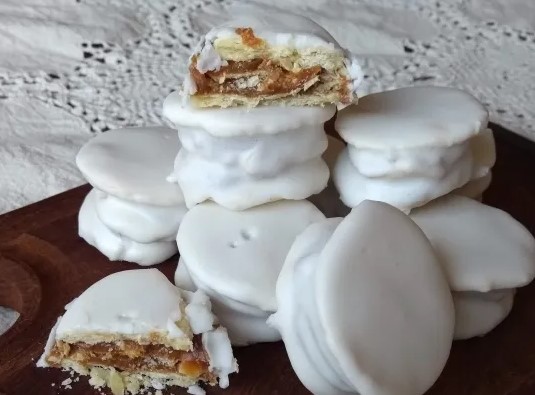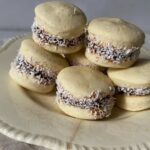In Argentina, alfajores are extremely popular, they are a classic treat that is enjoyed at all times. Likewise, it is estimated that Argentines consume around 6 million alfajores per day. For this reason, with so much fanaticism, the list of varieties is immense. From the famous “from Mar del Plata” to the kiosk classics, white or black, two or three layers, with a variety of fillings, some covered and others not, with crispy or spongy covers, etc. In addition, the provinces also join this competition, each with its particularity. Therefore, this time, we are going to teach you how to prepare the classic alfajores from Santa Fe. As its name indicates, this alfajor is native to the province of Santa Fe, located in the region called Litoral, northeast of Argentina.
In this article we teach you how to make easy alfajores from Santa Fe. Let’s go there!
Ingredients to make Santa Fe Alfajores:
- For the caps
- 125 grams of flour 0000
- 2 egg yolks
- 60 cubic centimeters of warm water
- ¼ gram of ointment butter
- 1 tablespoon of ethyl alcohol
- 1 pinch of salt
- For the filling
- 250 grams of Dulce de leche pastry
- For the glaze
- 1 egg white
- 250 grams of powdered sugar
- 25 cubic centimeters of lemon juice
- water amount needed
How to make Alfajores from Santa Fe:
- To start with the Santa Fe alfajores recipe, first place the flour in the shape of a crown on the counter.
- Next, in the center, add the yolks, the pinch of salt, the ethyl alcohol, the softened butter (that is, very soft at room temperature) and the water.
- Add the ingredients and start kneading.
- Knead for about 5 minutes until it forms a smooth bun, keep in mind that the dough should be somewhat compact.
- Next, cover the bun and let it rest in the fridge for 30 minutes.
- Roll out the dough about 2mm thick. Cut the discs with a 6 cm diameter circular cutter.
- Then, add any leftover scraps without kneading and roll out again to continue cutting discs, using as much of the dough as you can.
- If the dough shrinks a lot, let it rest again.
- Trick: with these quantities you will obtain approximately 9 white alfajores, 27 tapas.
- Place the discs on a clean plate or roasting pan and prick them with a fork.
- Then, take them to the oven preheated strong 200 ° C for 7 or 8 minutes.
- Then turn them over and put them back in the oven for a few more minutes.
- Trick: they should be golden brown, but pay attention because they burn easily.
- Remove the roast from the oven and place the caps on a wire rack to cool.
- When the tapas have cooled, form the alfajores by joining the 3 tapas with the dulce de leche. Then, place them on a grid, separated and then bathe them with the glaze.
- Next, prepare the glaze for the bath of the alfajores from Santa Fe. Also, place 1 white in the mixer bowl and beat them fora few minutes.
- Then, begin to gradually incorporate the powdered sugar.
- Continue incorporating the powdered sugar until you achieve a white coating for alfajores that, when you touch it, does not catch on your finger.
- Add a little lemon juice, which will serve to lighten the preparation and provide the classic white color.
- Also, incorporate by mixing with a spoon and continue adding the lemon juice or water little by little until you reach point 20 To recognize this point, drop a drop of the glaze from the spoon onto the rest of the mixture and count to 20.
- If the drop dissipates, you’re done. On the contrary, correct as appropriate: if it is still too hard, add more water or lemon and if it is too liquid, add more powdered sugar to thicken it.
- Tip: you can keep the glaze in the fridge for up to 1 week.
- To store it, place it in a container covered with plastic wrap in contact with the preparation, and then wrap the container with more plastic wrap (or an airtight lid), to prevent it from drying out in contact with the air.
- For the bath, place the rack with the alfajores from Santa Fe with empanada tapas on a plate or tray.
- Also, pour abundant glaze with a spoon on the surface of each alfajor. Help yourself with the same spoon or with a small spatula to completely cover each alfajor.
- This step must be done with patience, reviewing and correcting the coverage for alfajores one by one.
- Then, tap the grid a little on the plate so that the excess glaze falls off. You can reuse that surplus that falls. Now, wait for the glaze to dry.
- Tip: avoid touching the glaze until it is completely dry, as it marks easily. Drying time may vary depending on the weather, but may take up to 8 hours.
- Now you can enjoy these classic glazed alfajores.



